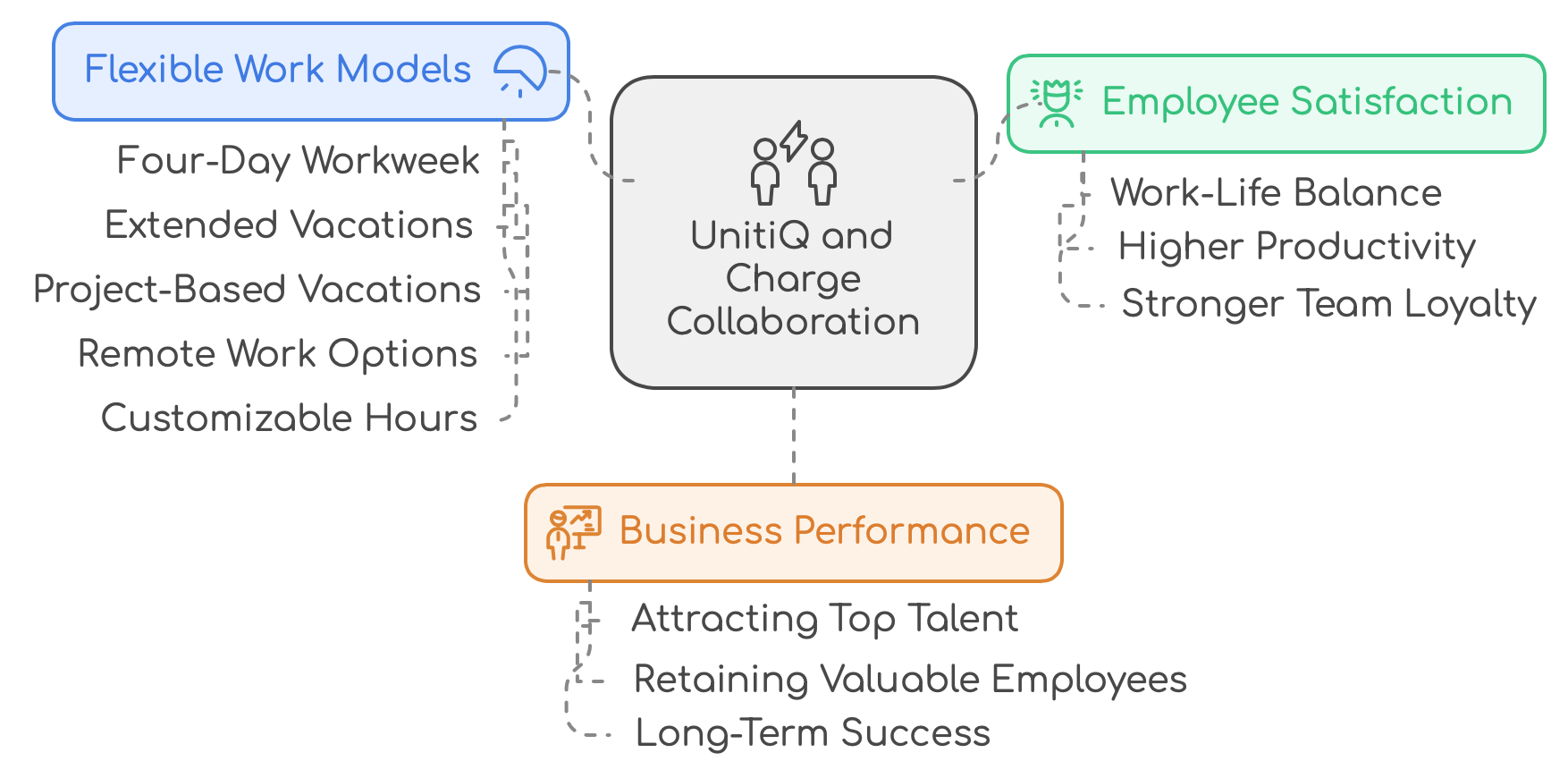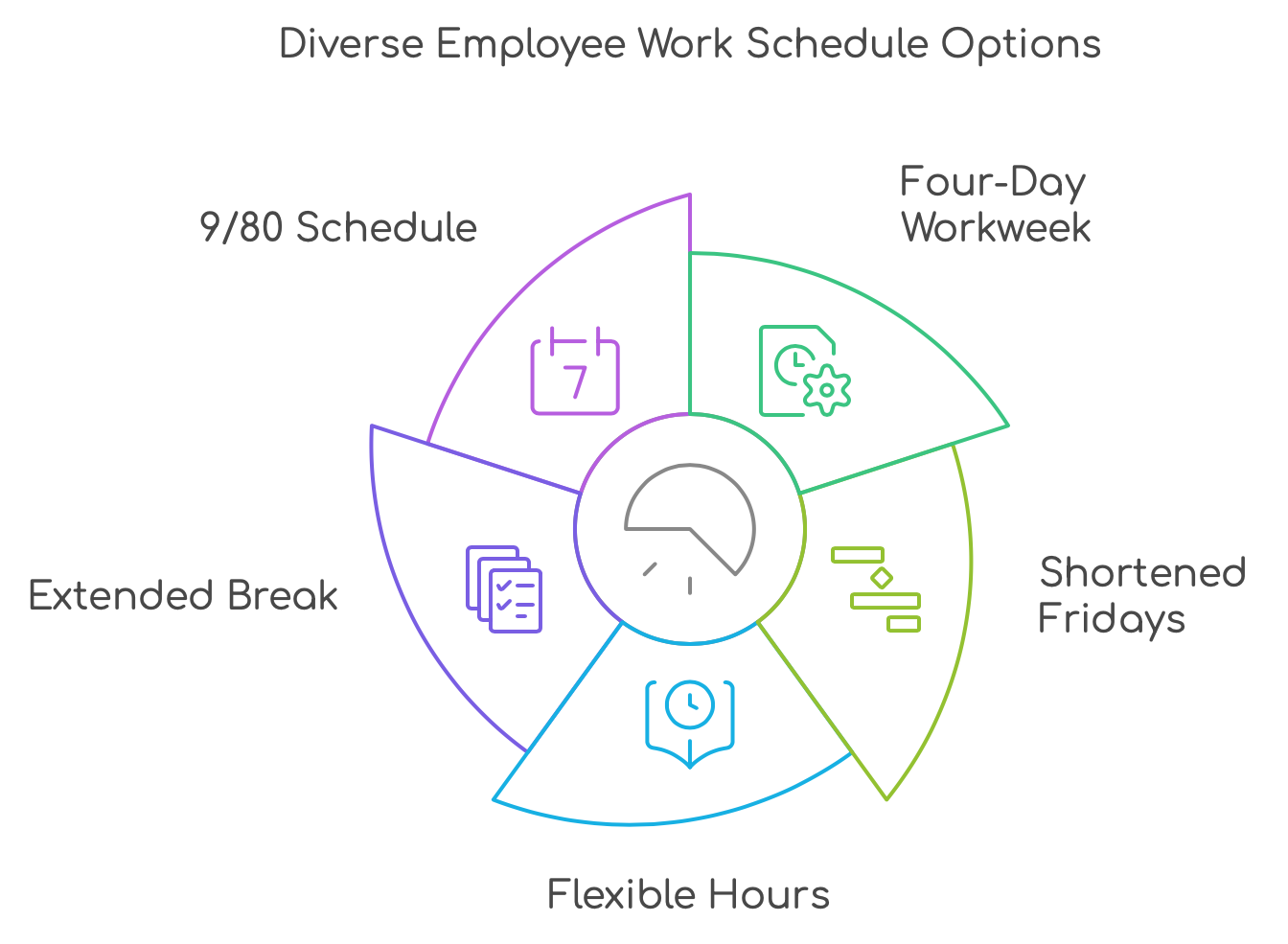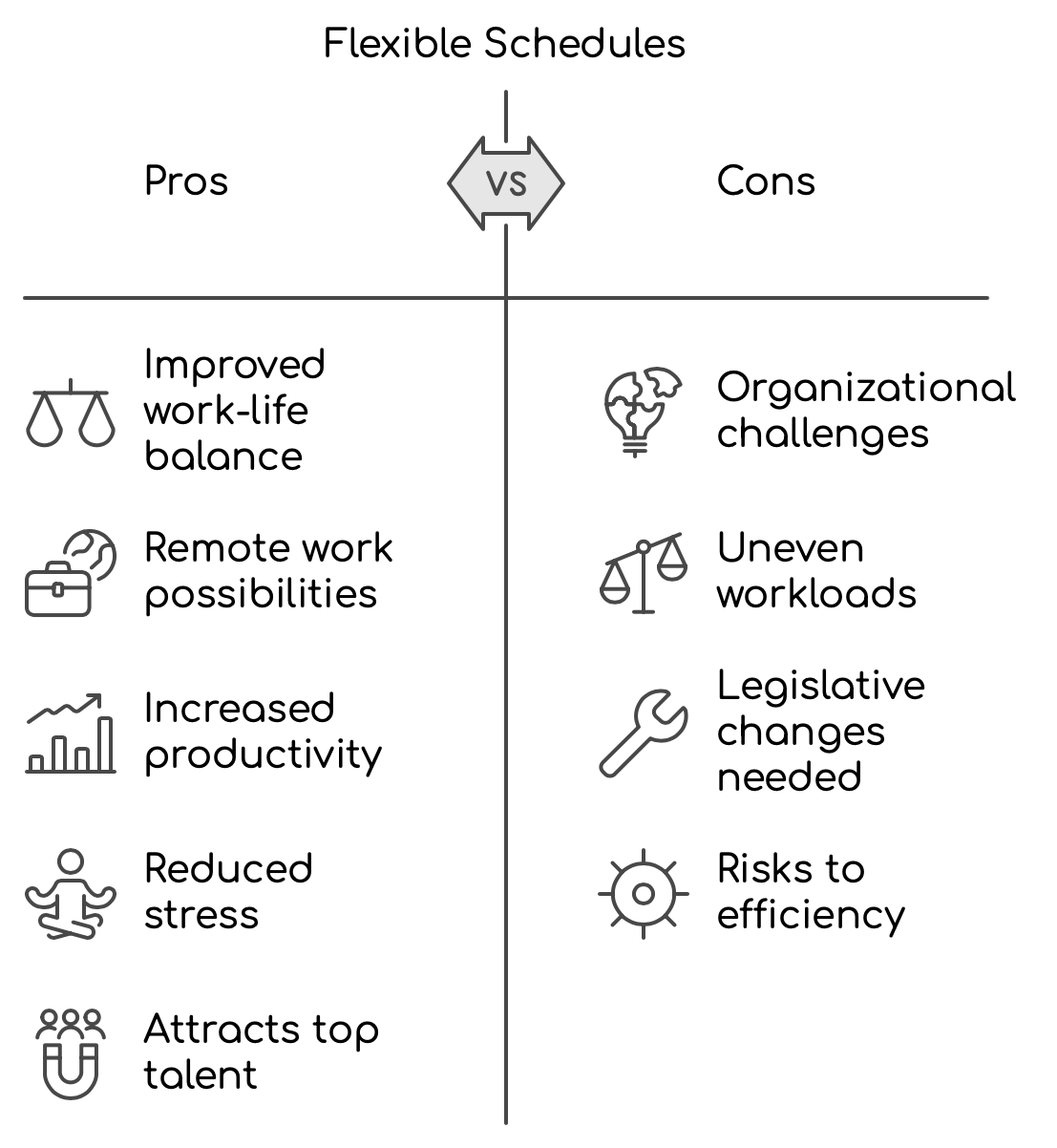Hi, I'm Olga Fedoseeva, Founder and CEO at UnitiQ. Recently, I had the pleasure of working closely with our client, Charge, to tackle a challenge many companies face: improving workplace flexibility without sacrificing performance. One afternoon, during a brainstorming session with their team, we realized that a one-size-fits-all schedule wasn't serving everyone.
We decided to pilot five different flexible work models. For example, some team members shifted to a four-day workweek, which gave them more time with family without impacting deadlines. Others opted for extended project-based vacations, allowing them to recharge after intensive projects.
The results were even better than we anticipated. Employee satisfaction increased noticeably, and we saw a boost in productivity. One employee told me that this new flexibility made them feel more valued and motivated at work.
This experience reinforced for me how tailored HR solutions can make a real difference. By combining UnitiQ's expertise with Charge's willingness to innovate, we created a work environment where people genuinely thrive.
This experiment exemplifies how fractional HR can deliver tailored, impactful solutions that meet modern workforce demands. With UnitiQ's deep expertise in human resources and Charge's openness to change, they’ve created a framework where both employees and the company thrive. By focusing on happiness and productivity through flexibility, Charge is now better positioned to attract top talent, retain valuable employees, and ensure long-term success.
We decided to pilot five different flexible work models. For example, some team members shifted to a four-day workweek, which gave them more time with family without impacting deadlines. Others opted for extended project-based vacations, allowing them to recharge after intensive projects.
The results were even better than we anticipated. Employee satisfaction increased noticeably, and we saw a boost in productivity. One employee told me that this new flexibility made them feel more valued and motivated at work.
This experience reinforced for me how tailored HR solutions can make a real difference. By combining UnitiQ's expertise with Charge's willingness to innovate, we created a work environment where people genuinely thrive.
This experiment exemplifies how fractional HR can deliver tailored, impactful solutions that meet modern workforce demands. With UnitiQ's deep expertise in human resources and Charge's openness to change, they’ve created a framework where both employees and the company thrive. By focusing on happiness and productivity through flexibility, Charge is now better positioned to attract top talent, retain valuable employees, and ensure long-term success.
How Fractional HR Transformed Talent Acquisition Through Flexible Work: Charge Case Study
The Challenge:
Charge faced the same talent acquisition problem as 73% of growing companies - difficulty attracting and retaining top talent in a competitive market where candidates prioritize work-life balance over traditional benefits.
The Solution:
Through strategic fractional HR partnership with UnitiQ, Charge implemented five flexible work models that transformed their employer brand and talent acquisition results.
The Results:
- 40% improvement in candidate attraction rates
- 35% reduction in employee turnover
- 85% employee satisfaction with work-life balance
- Became employer of choice in their industry

To boost employee happiness, Charge has introduced five types of flexible work schedules, ranging from a four-day workweek to project-based roles with two-month vacations. Imagine: fewer working days without any salary reduction, with work and personal life coexisting in harmony. This is a win-win - employees thrive while employers benefit from a happier and more loyal workforce. Yet, some companies hesitate, fearing that flexible schedules might lead to slacking or reduced productivity.
At Charge, we began experimenting with flexible work schedules in 2022. The results have been overwhelmingly positive—our employees are happier, more engaged, and we’ve seen a reduction in turnover. Moreover, job candidates now choose us more frequently over other companies. Here's how we implemented flexible schedules, the challenges we faced, and the outcomes we achieved.
The 5-Model Flexible Work Framework: Implementation Guide
Model 1: Four-Day Workweek
- Structure: 32-hour week, same productivity expectations
- Best for: Creative teams, project-based roles
- Implementation time: 3-month pilot, 6-month full rollout
Model 2: Shortened Fridays ("Weekend Warrior")
- Structure: Extra hour Mon-Thu, finish noon Friday
- Best for: Teams with weekly deliverables
- Employee adoption rate: 45% (most popular option)
Model 3: Flexible Daily Hours
- Structure: Choose start/end times, maintain core collaboration hours
- Best for: Individual contributors, parents
- Core hours requirement: 10 AM - 2 PM overlap
Model 4: Extended Project Breaks
- Structure: Intense project phases followed by 2-month paid breaks
- Best for: Senior developers, consultants
- Project completion bonus: Additional recovery time
Model 5: 9/80 Schedule
- Structure: 9 days over 2 weeks, extra day off biweekly
- Best for: Operations, customer service
- Workload distribution: Slightly longer daily hours
How Fractional HR Enabled Flexible Work Success
Strategic Planning Phase:
- Analyzed existing workforce needs and preferences
- Designed pilot programs with measurable KPIs
- Created change management framework
- Developed communication strategies
Implementation Support:
- Trained managers on flexible team leadership
- Created employee onboarding for each work model
- Set up performance measurement systems
- Handled policy and compliance considerations
Ongoing Optimization:
- Monthly performance reviews and adjustments
- Employee feedback collection and analysis
- Expansion planning for successful models
- Integration with talent acquisition strategy
Measurable Results: The Business Case for Flexible Work
Talent Acquisition Improvements:
- 40% increase in qualified applications
- 25% reduction in time-to-hire
- 60% improvement in offer acceptance rates
- 35% decrease in recruitment costs
Employee Retention Benefits:
- 35% reduction in voluntary turnover
- 50% decrease in sick days taken
- 85% employee satisfaction scores
- 90% would recommend company to others
Productivity Indicators:
- Project completion rates maintained or improved
- Client satisfaction scores increased 15%
- Employee engagement up 45%
- Work quality metrics unchanged or better
What Flexible Work Schedules Entail
Flexible work schedules allow employees to choose the length and timing of their workday. Based on insights from various companies, flexible schedules help workers better balance their professional and personal lives, leading to higher job satisfaction and overall well-being.
The rise of online professions and remote teams has shown that a rigid 9-to-5, eight-hour workday doesn't fit everyone. For departments like development and analytics, where there’s little direct interaction with customers, holding employees to a strict schedule is unnecessary.

Charge’s Journey to Flexibility
In the fall of 2022, we initiated a four-day workweek pilot. We closely monitored employee happiness metrics, especially the work-life balance indicator. The pilot revealed that flexible schedules made employees happier, and productivity increased.
The initial experiment involved 55 employees, which later expanded to 84. Over six months, employees worked a four-day week while we observed its impact on their performance and morale. Many reported improved happiness and a better work-life balance. In some departments, productivity even rose. However, we also encountered difficulties—certain roles couldn’t adapt to the new schedule, and a few employees opted to return to the traditional five-day workweek. The transition itself was stressful, akin to starting a new job, so we found that employees needed support to adjust.
Flexible Work Models: Our Experience
After the four-day workweek pilot, we refined our approach. Our new model caters to individual employee needs, allowing them to choose a schedule that works for them. We introduced a system offering five different schedules, tailored training programs, and created an onboarding course for each. By summer 2023, we launched the “Flexible Schedules” project.

In addition to the four-day workweek, employees now have the following options:
- Shortened Fridays: Employees work an extra hour Monday through Thursday, allowing them to finish work at noon on Fridays. This schedule, dubbed “The Weekend Warrior’s Dream,” has proven particularly popular, as it offers the perfect balance—employees still have time to wrap up work before starting their weekend early.
- Flexible Hours: Employees work five days a week but choose their start and end times. Early birds might start at 7 a.m., while night owls may begin around noon. Parents, for instance, can take a long break in the middle of the day to pick up their children from school.
- Extended Break: This is designed for employees deeply involved in a project who prefer not to take time off until the work is done. Upon project completion, they can take up to two months of paid leave, allowing for complete rest and recharging before tackling their next big task.
- 9/80 Schedule: Employees work nine days over a two-week period instead of ten. They extend their working hours slightly over eight days and earn an extra day off every two weeks.
Currently, 100 employees from various departments—legal, IT, accounting, HR, and project management - are participating. Each has found a schedule that enhances their happiness.
Overcoming Flexible Work Implementation Challenges
Challenge 1: Manager Resistance
- Problem: Concerns about productivity monitoring
- Solution: Results-based performance metrics, manager training
- Outcome: 95% manager satisfaction with new approach
Challenge 2: Client Communication
- Problem: Ensuring availability during business hours
- Solution: Core hours policy, clear communication protocols
- Outcome: No client complaints, improved satisfaction
Challenge 3: Team Coordination
- Problem: Scheduling meetings across different schedules
- Solution: Shared calendar system, asynchronous communication tools
- Outcome: Meeting efficiency improved 20%
Scaling Flexibility Across Charge
We believe this experiment in flexible scheduling can be scaled company-wide, though some tweaks are needed. Here’s our plan for the future:
- We’re training AI models to optimize the match between employee preferences and job requirements.
- Automation will make it easier for employees to inform teams of their chosen schedules.
- We’ll expand the selection of available schedules even further.
How to Track Time with a Flexible Schedule
Each company must decide how to track work hours based on its unique needs. Some use in-house systems, while others rely on tools like Odoo. At Charge, we decided to forgo strict time tracking, instead focusing on trust and results. We don’t monitor hours through software; instead, we base salary on the employee’s contract. Our philosophy is simple: it’s not about hours worked, but outcomes achieved.
We aim to cultivate a culture of trust, and we’ve shifted the focus from clocking hours to achieving results. If an employee finishes all their tasks by midday, we don’t keep tabs on what they do afterward. Our goal is to measure happiness and productivity, not time spent at a desk.
Employee Feedback on Flexible Schedules
Our employees have embraced these changes with open arms. Kira Smirnova, Director of Sustainable Development, said that a major success factor is respecting each other’s time—no after-hours messages, no weekend work interruptions. This keeps everyone well-rested and energized for the workweek. Meanwhile, Olga Dmitrieva, a lawyer, emphasized how flexible schedules allow her to live comfortably for both her family and herself, not just for work. Employees agree that Charge’s commitment to work-life balance is a game-changer.
Pros and Cons of Flexible Schedules

As with any system, flexible work schedules come with their own advantages and disadvantages.
Pros:
- Improved work-life balance.
- Remote work possibilities across time zones.
- Increased self-assessed productivity.
- Reduced stress and burnout.
- Attraction and retention of top talent.
Cons:
- Organizational challenges in implementing schedules.
- Potentially uneven workloads on certain days.
- The need for legislative changes to accommodate such flexibility.
- Poorly managed systems could pose risks to business efficiency.
Expert Recommendations from UnitiQ
Flexible schedules can boost productivity and profitability, but the primary goal is to make employees feel happier and more engaged. Here’s what we’ve learned and recommend for companies looking to implement this:
- Define measurable metrics to evaluate the effectiveness of flexible schedules.
- Regularly track these metrics to identify issues and opportunities for improvement.
- Foster open communication—encourage honest feedback, even when it’s not what you want to hear.
- Support employees through the adaptation phase, which could take up to three months. Provide training and resources, such as time management courses, to help them adjust.
- Introduce changes gradually—start with one or two departments before scaling across the company.
- Prepare leaders to manage teams with flexible schedules and adapt to this new way of working.
Our experience shows that work schedules must be adaptable to meet employee needs. We’ve realized that productivity isn’t tied to hours worked but to flexibility that aligns with individual preferences and responsibilities. Moving forward, we plan to expand our flexible schedules across the company and fine-tune them for each team and individual.
Flexible Work Implementation: Frequently Asked Questions
How do you maintain productivity with flexible schedules?
Focus on outcomes rather than hours. Set clear deliverables, use project management tools, and conduct regular check-ins. Charge saw productivity maintain or improve across all flexible models.
What legal considerations apply to flexible work arrangements?
Ensure compliance with local labor laws, update employment contracts, and maintain accurate record-keeping. Fractional HR support is crucial for navigating these requirements.
How do you handle client expectations with flexible schedules?
Establish core business hours, set clear communication protocols, and maintain service level agreements. Transparency and planning prevent client concerns.
What's the cost of implementing flexible work programs?
Initial investment includes training, system setup, and policy development. ROI typically positive within 6 months through reduced turnover and improved productivity.
Instead of Conclusion
Charge's experiment with flexible work schedules is forward-thinking and aligns well with modern trends in talent acquisition and retention. In today's competitive job market, creating an environment where employees feel trusted and can balance their personal and professional lives is critical.

Your Path to Flexible Work Success
Charge's transformation from traditional schedules to flexible work models wasn't just an HR initiative - it became a competitive advantage in talent acquisition and retention.
Key Success Factors:
- Strategic fractional HR partnership for expert guidance
- Pilot approach with measurable KPIs
- Employee-centric design with multiple options
- Strong change management and communication
- Focus on results rather than hours worked
Ready to transform your talent acquisition through flexible work?
UnitiQ's fractional HR services have helped over 50 European companies implement successful flexible work programs with an average 35% improvement in talent attraction rates.
Fractional HR solutions, such as flexible schedules, can significantly improve employee satisfaction, reduce turnover, and attract top talent. It’s inspiring to see a company recognizing that employee well-being directly impacts productivity and long-term success. Implementing a culture of trust and flexibility can make a company a desirable place to work and help it thrive in the long run.
If you need any help with HR, contact me directly for getting the offer tailored to your specific needs and requirements.
We are happy to help with your HR Operations and Hiring. Here are direct contacts of Olga Fedoseeva, Founder at UnitiQ:
My Telegram
My LinkedIn
If you need any help with HR, contact me directly for getting the offer tailored to your specific needs and requirements.
We are happy to help with your HR Operations and Hiring. Here are direct contacts of Olga Fedoseeva, Founder at UnitiQ:
My Telegram
My LinkedIn
Author
Olga Fedoseeva is an award-winning HR executive and people strategist with over 20 years of international experience across EMEA, the US, and APAC. Currently Chief of Staff at Exponential Science and Founder of UnitiQ, she has personally hired more than 1,000 employees and scaled organizations from 30 to 3,000 staff. Recognized as one of the Top HR Women in EV (2021), Olga has led global HR transformation, talent acquisition, and people operations for startups, scale-ups, and multinational enterprises. Her expertise spans the full HR lifecycle—succession planning, DEI, HR tech integration, workforce planning, and executive coaching—helping businesses align people strategies with growth objectives while fostering inclusive, high-performance cultures.
